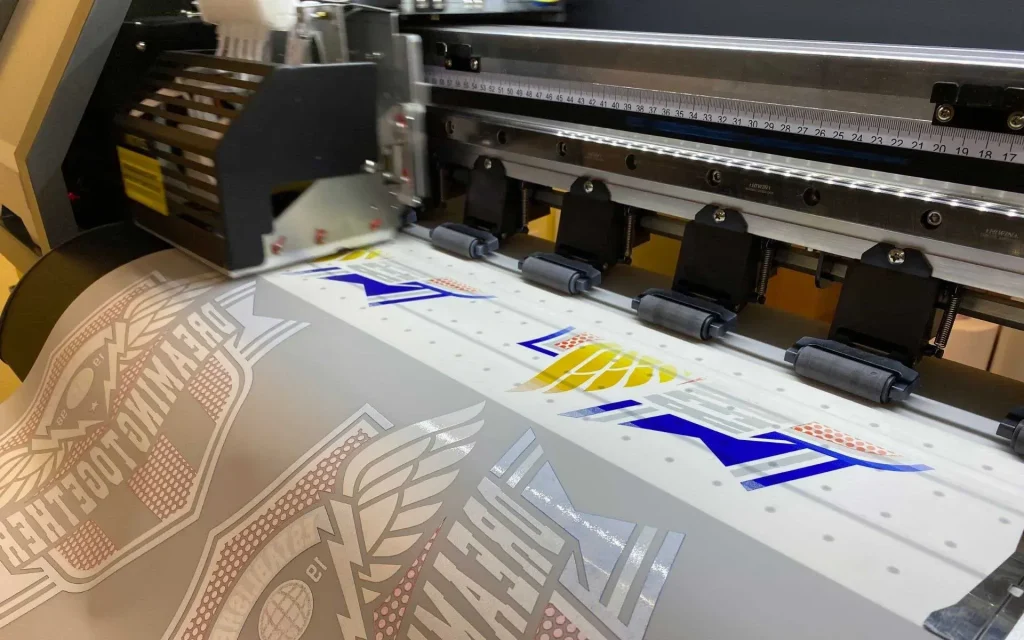DTF printing, or Direct-to-Film printing, has quickly gained traction as a cutting-edge method in the world of textile printing. This innovative process allows for high-definition designs to be printed onto a specialized film, which can then be easily transferred onto various fabrics, making it a favored choice among designers and businesses alike. The benefits of DTF printing include vibrant color reproduction, excellent wash durability, and the ability to print on a wide range of materials, from cotton to polyester. As sustainable printing methods become increasingly important, DTF printing stands out for utilizing water-based inks and non-toxic adhesives, aligning with eco-friendly practices. In this article, we will explore the DTF printing process in detail, highlighting its numerous applications in the fashion and promotional merchandise industries.
Within the realm of contemporary textile production, the Direct-to-Film technique has emerged as a game-changer, revolutionizing how designs are applied to fabrics. Often referred to as DTF technology, this printing method utilizes a transfer film to ensure sharp and colorful prints that adhere brilliantly to garments. The comprehensive benefits of this approach include its adaptability to various fabric types and its environmentally conscious use of water-based inks. As industries seek out effective and sustainable printing solutions, the DTF printing process has gained significant recognition, making it an ideal choice for bespoke fashion and customized promotional items. Join us as we delve into the intricacies of this remarkable printing technology, uncovering its implications and uses in diverse applications.
The Mechanics of the DTF Printing Process
The mechanics behind Direct-to-Film (DTF) printing lie in its innovative approach to transferring designs onto a range of fabrics. The process begins with the printing of images onto a specialized transfer film using a cutting-edge inkjet printer. This film is coated with a unique polymer material that allows the ink to adhere effectively. By utilizing water-based inks, DTF printing not only ensures vibrant colors but also offers an eco-friendlier alternative to traditional printing methods. The precision involved in this initial stage sets the tone for high-quality results.
After the initial printing, an adhesive powder is applied to the wet ink on the film. This step is crucial as it helps the design bond to the fabric during heat transfer. The film undergoes a curing process where heat is applied to solidify the adhesive, allowing for durability and softness in the final product. This meticulous procedure transforms a simple file into a lasting piece of wearable art, showcasing the extraordinary precision and efficiency of DTF printing.
Benefits of DTF Printing in the Modern Printing Landscape
DTF printing provides a multitude of benefits that make it an attractive choice for both small businesses and large-scale manufacturers. One of the major advantages is the cost-effectiveness of the process. Unlike screen printing, which requires extensive setup and labor for each design, DTF printing allows for quick project turnaround without sacrificing quality. This makes it ideal for custom orders and low-volume runs, catering directly to customer needs.
Furthermore, DTF printing boasts exceptional print quality and durability. The combination of high pigment concentration and water-based inks ensures that prints not only have striking visuals but also withstand washing and wear over time, maintaining their vibrant appearance. This capability makes DTF printing particularly appealing for sports uniforms and promotional merchandise, where longevity is essential.
Applications of DTF Printing Across Various Industries
DTF printing’s versatility enables it to cater to a broad spectrum of applications, spanning across fashion, sports, and promotional items. In the fashion industry, custom t-shirts and hoodies are frequently produced using DTF techniques, allowing brands to showcase unique designs that appeal to diverse audiences. DTF printing excels in creating vibrant, soft-feel prints that enhance the overall garment aesthetics.
In sports apparel, the flexibility and resilience of DTF prints make them ideal for uniforms that endure rigorous play. Whether it’s for amateur leagues or professional teams, DTF printing delivers high-quality results that athletes can wear confidently. Additionally, businesses leverage this printing method for promotional merchandise, creating custom-branded clothing that makes a lasting impression at events or as part of corporate giveaways.
Sustainable Practices in DTF Printing
In recent years, the call for sustainability in manufacturing has influenced numerous industries, including garment printing. DTF printing embraces this movement by utilizing eco-friendly materials such as water-based inks and non-toxic adhesives. These innovations significantly reduce the environmental impact compared to traditional printing methods that often rely on harsh chemicals.
Adopting sustainable practices not only appeals to eco-conscious consumers but also helps brands enhance their ethical image in a competitive market. As the demand for environmentally friendly options grows, DTF printing positions itself as a leader by providing a method that aligns quality with sustainability, paving the way for more conscientious choices in the textile industry.
Navigating the Future of DTF Printing Technology
As technology evolves, so does the potential for DTF printing. Recent advancements in ink formulations and adhesive properties are continuously enhancing print quality and washability. These innovations provide businesses with a competitive edge in meeting consumer demands for high-quality, durable, and visually appealing products.
Moreover, the integration of digital printing technologies into the DTF process signifies a pivotal shift towards greater efficiency and customization. As manufacturers and designers harness these developments, the possibilities for creative expression are virtually limitless, ensuring that DTF printing remains at the forefront of the evolving landscape of garment decoration.
The Rise of DTF Printing: A Game Changer for Custom Printing
The rise of DTF printing represents a monumental shift in the custom printing industry, capturing the attention of both small entrepreneurs and established businesses. This printing method has created new opportunities for customization, enabling users to produce intricate designs with ease. As DTF printing technology continues to evolve, its accessibility and user-friendliness have positioned it as a go-to choice for many looking to start their own printing ventures.
The competitive nature of the DTF market, coupled with the technology’s capability to handle diverse fabric types, is driving rapid growth within the sector. As businesses recognize the advantages of investing in DTF printing equipment, they are positioning themselves to meet the growing consumer demand for unique, high-quality printed products.
Frequently Asked Questions
What are the key benefits of DTF printing?
DTF printing, or Direct-to-Film printing, offers numerous benefits including vibrant color reproduction, versatility across various fabric types, and durability of prints. This method utilizes water-based inks and a specialized adhesive, making it eco-friendly compared to traditional printing techniques. Additionally, DTF prints maintain their quality over time even after multiple washes, making them suitable for garments that see regular use.
How does the DTF printing process work?
The DTF printing process involves several critical steps: First, the design is printed onto a transfer film using water-based inks. Then, hot melt adhesive powder is applied, which binds to the wet ink. After curing the film with heat, the design is transferred onto the fabric using a heat press. This ensures a durable and vibrant final print that feels soft to the touch.
What types of fabrics can DTF printing be used on?
DTF printing is highly versatile and can be applied to a wide range of fabrics, including cotton, polyester, blends, and more. This flexibility allows for various applications, from custom t-shirts and hoodies to durable sporting apparel, making it an excellent choice for any garment printing needs.
Is DTF printing an environmentally friendly option?
Yes, DTF printing is considered a more sustainable printing method. It primarily employs water-based inks and non-toxic adhesives, which reduce the environmental impact compared to traditional solvent-based inks. As sustainability in the textile industry becomes a priority, DTF printing stands out as an eco-friendly alternative.
What are some common applications of DTF printing?
DTF printing is commonly used for creating custom designs on items such as t-shirts, hoodies, and sports uniforms. Additionally, it is popular in producing promotional merchandise since it offers vibrant and durable prints that can withstand regular wear. Its adaptability to various fabrics makes it suitable for diverse garment types.
How does DTF printing compare to other printing methods like DTG and screen printing?
Compared to DTG (Direct-to-Garment) and screen printing, DTF printing provides an edge in versatility and cost-effectiveness, especially for small runs and detailed designs. DTF prints are known for their durability and vibrant colors, while also being quicker and requiring less setup time than screen printing, making it a compelling choice for modern printing needs.
| Key Point | Details |
|---|---|
| What is DTF Printing? | A printing method where designs are printed onto transfer film using water-based inks before applying to fabric. |
| Key Process Steps | 1. Film Preparation 2. Adhesive Application 3. Curing 4. Transfer Application |
| Recent Developments | – Quality Enhancements – Environmental Considerations – Market Growth |
| Applications of DTF Printing | – T-shirts and Hoodies – Sporting Apparel – Promotional Merchandise |
Summary
DTF printing, or Direct-to-Film printing, has emerged as a leading method in the garment printing industry due to its unique approach that enhances quality and sustainability. This innovative technique allows for the creation of vibrant, durable prints that can be applied to a variety of fabrics, making it a versatile solution for custom apparel. As it continues to evolve, DTF printing not only meets the demands of modern consumers but also addresses environmental concerns through the use of eco-friendly materials. With its growing popularity among small businesses and custom print shops, it’s clear that DTF printing is shaping the future of textile printing and providing dynamic options for designers and businesses alike.


